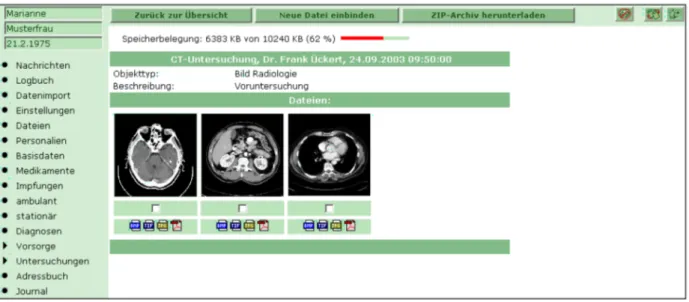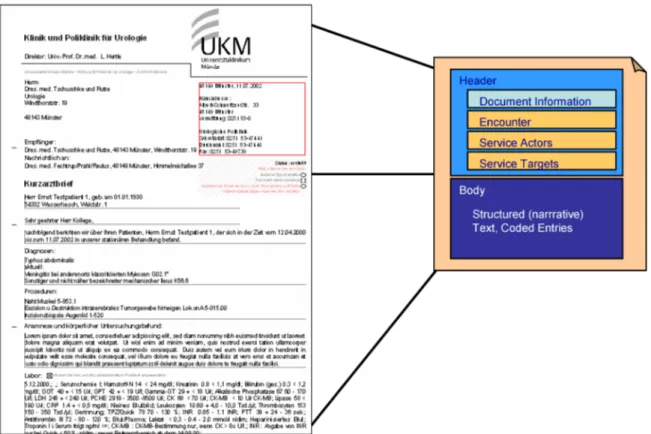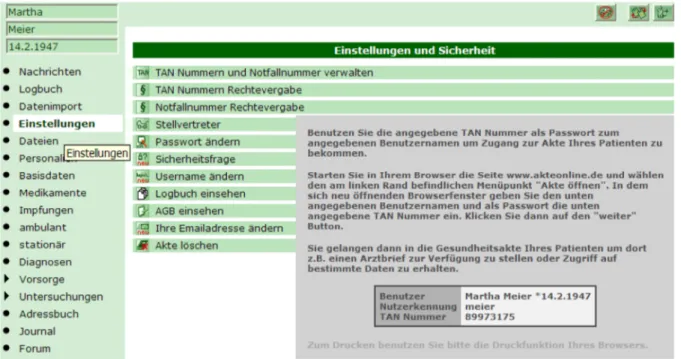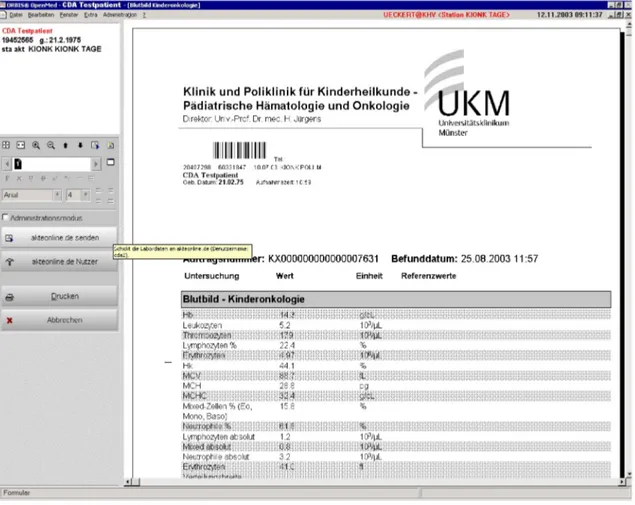An electronic health record to support patients and institutions of the health care system
Eine elektronische Gesundheitsakte zur Unterstützung von Patienten und Institutionen des Gesundheitswesens
Abstract
The department of Medical Informatics of the University Hospital Mün- ster and the Gesakon GmbH (an university offspring) initiated the co-
Frank Ückert
1Marcel Lucas Müller
2operative development of an electronic health record (EHR) called "akte-
Thomas Bürkle
3online.de" in 2000. From 2001 onwards several clinics of the university
Hans-Ulrich Prokosch
4hospital have already offered this EHR (within pilot projects) as an ad- ditional service to selected subsets of their patients. Based on the ex- periences of those pilot projects the system architecture and the basic
1 University Hospital of Muenster, Children's data model underwent several evolutionary enhancements, e.g. imple-
mentations of electronic interfaces to other clinical systems (considering
Oncology, Muenster, Germany
for example data interchange methods like the Clinical Document Archi- tecture - standardized within the HL7 group - and also interfacing archi-
2 University Hospital of Freiburg, Dermatology Clinics, Freiburg, Germany
tectures of German GP systems, such as VCS and D2D). "akteonline.de"
in its current structure supports patients as well as health care profes- sionals and aims at providing a collaborative health information system
3 University Hospital of Muenster, Department of which perfectly supports the clinical workflow even across institutional
boundaries and including the patient himself. Since such an EHR needs
Medical Informatics and to strictly fulfill high data security and data protection requirements, a
Biomathematics, Muenster, Germany
complex authorization and access control component has been included.
Furthermore the EHR data are encrypted within the database itself and
during their transfer across the internet. 4 University Hospital of
Erlangen, Institute for
Zusammenfassung
Im Jahr 2000 initiierten das Institut für Medizinische Informatik und Biomathematik der Universität Münster und die Gesakon GmbH ein
Medical Informatics, Biometry and Epidemiology, Erlangen, Germany
Kooperationsprojekt zur gemeinschaftlichen Entwicklung einer Elektro- nischen Gesundheitsakte (EGA), genannt „akteonline.de". Seit 2001 wurde diese EGA bereits von verschiedenen Kliniken des Universitäts- klinikums Münster bestimmten Zielgruppen aus ihrem Patientengut als zusätzlicher Service im Rahmen verschiedener Pilotprojekte angeboten.
Aufbauend auf den Erfahrungen dieser Pilotprojekte wurden die zugrun- de liegende Systemarchitektur und das Datenmodell mehreren evolu- tionären Weiterentwicklungen unterworfen. Unter anderem gehörte dazu das Design von Schnittstellen zu anderen medizinischen Informa- tionssystemen (hierfür wurden sowohl der von der HL7-Gruppe definierte Standard der „Clinical Document Architecture (CDA)" als auch die in deutschen Arztpraxissystemen vielfach schon etablierten Lösungen wie VCS und D2D berücksichtigt). "akteonline.de" unterstützt zurzeit sowohl Patienten als auch Gesundheitsbetreuer und hat es sich zum Ziel ge- setzt, als „collaborative health information system" diagnostische und therapeutische Prozesse auch sektorübergreifend und selbst den Pati- enten unmittelbar einbeziehend zu unterstützen. Aufgrund der hohen Sensibilität der in einer solchen EGA zu speichernden Patientendaten wurde eine umfangreiche Autorisierungs- und Zugriffregelungskompo- nente implementiert. Zusätzlich werden die Daten der EGA sowohl während ihres Transports über öffentliche Netze als auch in der Daten- bank selbst verschlüsselt.
ship." [1]
The value of empowered patients having at least partial access to their own medical data is already known to and proven in the literature [2], [3]. As an example one can think of the patient's better understanding of his health condition with all the concluding advantages [4].
The internet offers not only worldwide access possibilities, which are independent from time and place, but also adds „radically new facets to health care" [5]. Anglo- American literature reports that 40-54% of all patients are using the internet as a source for medical information and that they depend on that information for their own medical decisions [6]. We should be careful to assume these numbers also for the German society, but we are able to watch similar trends in Germany.
The potential advantage of a secure and transparent connection between information systems in hospitals, doctor's practices, pharmacies and other health care provider sites is overwhelming. However, most of the ex- isting projects to establish such integrated networks still neglect the patient's right to be an empowered partner in all his care decisions and to control the communication of his medical record (or parts of it) between his health care providers. In our opinion, an electronic health record (EHR) in the possession of the patient with free definable levels of access authorizations to the EHR contents will enhance the patient's role in the care process and offer new opportunities of networking and electronic data in- terchange between his health care providers.
Therefore the objectives of the EHR akteonline.de are:
• to give the patient the possibility to manage his own medical data electronically,
• to support the management of those data via internet independent from time and place,
• to incorporate data from different medical applications and systems (e.g. Hospital Information Systems, General Practitioner Systems) automatically and integrate them into one personal health record,
• to make personalised health care information available to the patient,
• to serve as a medium for the communication of health care information between health care professionals, and finally
• to support preventive medical treatment through inte- grated reminder functions, which can be a basis for ad- vanced disease management.
practitioners is still an open problem (at least in Ger- many). The main reason for this seems to be heteroge- neous approaches and system architectures which are pursued by vendors of hospital information systems on one side and general practitioner (GP) system vendors on the other side. No reliable standard has been estab- lished yet for exchanging structured information between such systems. Diverging communication standards between German ambulatory care environments ("xDT"
comprising message types such as LDT ("LaborDaten- Träger", laboratory data carrier), ADT ("AbrechnungsDaten- Träger", accounting data carrier) or BDT ("Behandlungs- DatenTräger", treatment data carrier)) and German hos- pital environments where mostly HL7 is used form a considerable barrier which must be overcome. In order to solve such cross-sectoral communication problems the German project "Standardized Communication of In- formation Systems in Physician Offices and Hospitals using XML" (SCIPHOX) [7] has applied the "Clinical Docu- ment Architecture" (CDA) [8], developed by the HL7 group [9] and based on XML [10], [11], as a promising new approach for structuring and exchanging medical data between institutions. In our opinion it offers an ideal way for spanning bridges between institutional information systems and the personal EHR of a patient.
Materials and methods
According to the above described goals which were pur- sued with the development of akteonline.de its function- ality is much more comprehensive than other EHR imple- mentations, especially in the US [12]. Beyond its basic functionality to provide a web-based user interface for the empowered citizen to access his internet-based per- sonal electronic health record, it has been designed from the beginning to include additional functionality, to in- crease the benefits and usability for the patient.
The EHR contents
The contents of the EHR comprises basic demographic data, a record of all outpatient and inpatient visits, diag- nostic findings (including also radiology images), diag- noses and performed procedures, a lifelong medication record, personal risk data (e.g. allergies), vaccinations, and clinical referral letters. Figure 1 shows an exemplary
Figure 1: View of a patient's medication record in akteonline.de. Context sensitive links like the shown "search in several internet search engines" to access further drug information for a selected drug have been established.
Figure 2: Detailed view of a multimedia data object (in this example DICOM radiology images) with thumbnail preview within akteonline.de.
screenshot of a citizen's medication record. Figure 2 illus- trates the capabilities to include multimedia objects such as radiology images in various image formats.
Patient information
As additional service information for users as well as health care professionals a medical knowledgebase with medical information on clinical topics has been included, focusing on the specific diseases (e.g. breast cancer, leukaemia) which our pilot projects have focused on.
Further to the medical information directly included within akteonline.de, links have also been established to relevant internet based information resources (e.g. a link to drug information systems which is directly integrated within the drug data entry form; compare Figure 1).
Supporting preventive care
The concept of akteonline.de has been extended to in- clude not only "passive knowledge sources", but to provide active reminder functions. Such reminder functions can inform a citizen about necessary vaccination dates or
remind him to follow-up visits, e.g. in case of chronic dis- eases.
Integration with other clinical information systems
One of the most important steps during the development of akteonline.de was to provide additional ways to enter clinical data not only manually by using web-based data entry forms. A patient would not accept, that a referral letter which is electronically created within a hospital in- formation system can not be automatically transferred into his EHR after his discharge from a hospital. Therefore it was a major issue to establish standardized and open interfaces to integrate data from the hospital information system (HIS) of the University Hospital of Muenster. The HIS possesses an extensive programming interface to design new forms and to link external application com- ponents. This features have been applied to define an electronic form within the HIS environment for the cre- ation of a referral letter which gathers most of the needed data, like personal data, lab results and other examination
Figure 3: Dividing a referral letter into the different CDA fields in order to establish a standardized data input interface for akteonline.de
results, diagnoses and procedures, from the HIS database itself.
In addition an external process has been implemented which may be initiated by the HIS from within the referral letter module. This process receives the contents of the letter and converts it into a CDA based XML-structure (Figure 3).
A CDA document is typically made of a header, which contains general standardized information about the document (e.g. the actors like the physician, the patient, and the institution), and the body, in which the detailed information is included in a structured form. In the current CDA specification unfortunately the granularity of struc- tured information is not yet detailed enough to extract structured parts of a letter, such as diagnoses, proced- ures, or recommended future therapy in full detail.
If the respective patient possesses an electronic health record account within akteonline.de, a third process es- tablishes an upload link to the EHR and imports the refer- ral letter. In another project the same conceptual ap- proach has been applied to import clinical documents in CDA format also into a GP system [13].
The signed referral letter form can either be printed or send as an encrypted and signed CDA document, so that an additional value for the patient could be generated and integrated into the normal clinical workflow without increasing the clinical workload.
This architectural approach allows establishing new data input mechanisms into akteonline.de, not only for referral letters, but for all types of clinical documents which can be structured according to CDA definitions.
Security and authorization
Data encryption, secure authorization, and comprehen- sive, but flexible access regulations are basic require- ments when such an EHR shall be used as an internet- based system. Therefore much effort has been put into this area. The complete security and access model has been published in an earlier paper [14]. Here we will only em-phasize some major issues which have been tackled during the design of akteonline.de.
In theory, every citizen can open an akteonline.de account in order to create his/her personal electronic health re- cord. Since the majority of akteonline.de pilot projects are centred on juveniles, children, babies, and newborns (these patients typically do not have the necessary knowledge and may be too young to manage an own EHR), a deputy model has been implemented, where every user can define one or more deputies, who have full access rights to maintain the EHR instead of the ori- ginal record owner.
Health care providers may be defined as "users" within akteonline.de. They do, however, not posses an own re- cord. Instead every patient can define access rights (on his whole personal record as well as on selected sub- items) for such a health care provider, either on a perman- ent basis or for a single access.
Authentication for one time access to a patient's record is established using "transaction numbers" (TAN), similar to online banking methods.
As an important difference to online banking, the owner of an EHR can himself define a one time access profile
Figure 4: TANs can be generated and printed from the "settings menu" of akteonline.de. Predefined access profiles are associated which each TAN.
(selecting the type of access, e.g. read or write, and the data subset of his record to which he wants to provide this access) and then generate an associated TAN (Figure 4). He may then choose to print this TAN and hand it to a health care provider during his next visit. This healthcare provider may use the TAN for one single access to EHR where he may just perform exactly the type of access which has been previously defined by the record owner.
Thus the patient himself has the full control over the ac- cess to his/her personal record. Such a TAN can also be used as a one time key for the automated upload of electronically created documents, as described in the previous section.
Results
At the moment there are documents for exchanging lab results and referral letters on the basis of the CDA in routine use.
The lab device sends its data as HL7 messages to the HIS and a staff member can send the lab results encryp- ted over the internet from the HIS to the EHR (Figure 5, Figure 6). As usual for CDA documents, also the acting persons and the institution are embedded. The document is signed on receiving and akteonline.de prevents chan- ging of the document in the future.
This feature is heavily used between the department of pediatric oncology and several of its juvenile patients.
The physician in hospital as well as the general practition- er involved in the treatment of those patients can add laboratory data to the patient record when needed. Inside the hospital this is merely a click on a "send to EHR"
button inside the regular lab report form, in GP practice it is mostly done via web access using a TAN number
provided by the patient's parents. The clinical advantage is now that inpatient lab data as well as outpatient lab data, especially hemoglobin, hematocrit, and platelet count are available in continuous follow-up at a glance.
Together with his GP and the responsible physician in the hospital the patient respectively his parents may look at those data and decide if the time for an additional chemotherapy, which is heavily dependent on those val- ues (especially the platelet count must be within certain ranges), has come. Unnecessary visits in the hospital may thus be avoided.
So far a few hundred lab reports for hundred pediatric oncology patients have been stored. Thorough evaluation of the effects is planned.
The writing of a short referral letter within the HIS enables the integration with already existing data. The staff is able to automatically generate a CDA document from it and send it securely over the internet to the EHR of the cor- responding patient (Figure 7, Figure 8).
The medical information in the documents can be auto- matically linked with further information for the patient and/or the next viewing healthcare professional (HCP).
Furthermore a search in several internet search ma- chines, like shown in Figure 1, can be triggered by the user.
Figure 5: Screenshot 1 illustrating the exchange of lab results from the HIS to the EHR
Figure 6: Screenshot 2 illustrating the exchange of lab results from the HIS to the EHR
Figure 7: Screenshot 1 illustrating the exchange of referral letters between the HIS and the EHR
Figure 8: Screenshot 2 illustrating the exchange of referral letters between the HIS and the EHR
data. For clinical staff the solution has been fully inte- grated into the normal workflow e.g. of lab data review or writing discharge letters. CDA has proven to be a suit- able and flexible standard for the exchange of structured medical data. In principle, all content of a HIS can be mapped into CDA documents and could be exported. In contrast to the exchange of unstructured documents (e.g.
PDF-files) the CDA documents can be machine processed at the receiving side. Speaking of the referral letters, in akteonline.de the diagnoses, the procedures and the medications can be extracted and may be used to trigger different actions. However, so far the actual CDA specifi- cation provide not yet sufficient granularity of information and they are not sufficiently adapted to the German health system. The SCIPHOX project [7] is developing several CDA conform extensions e.g. for diagnoses, insur- ance information and lab results, which helped us to overcome some of those barriers.
An EHR standing alone in the space of telemedicine does not make sense. "The consumer-driven products and services provided via the Internet are a potentially import- ant and beneficial complement of traditional health ser- vices. They affect the health consumer-provider roles and require changes in healthcare practices" [5]. In Germany there are the communication methods called VCS (VDAP Communication Standard, VDAP = Verband Deutscher Arztpraxis-Softwarehersteller e.V.) [15] and D2D (Doctor- To-Doctor) [16] in routine use. They handle communica- tion on a more technical level and can be expanded to exchange CDA documents. In this context, the EHR ak- teonline.de fits into the scenery very well, because both methods can be well combined with internet based technology.
Discussion of influence on patients and doctors
For the patient several advantages can be achieved with the help of an easy and modular expandable EHR with secure access management and extensive functions.
They include
• evading unnecessary double examinations,
• reducing the rate of ineffective therapies,
• enabling the patient to deal actively with his own medical condition,
(or "customer" in this case), and
• offering personalized health information depending on the actual medical conditions of the patient.
Many scientists already have evaluated the value of an empowered patient with access to his own medical data [2], [3]. Cimino and colleges for example reported a study, where patients and their caring physicians are concluding, that their communication and the compliance of the pa- tient have been improved [4].
On the other hand, Kim and Johnson tested the function- ality of eleven American EHRs and came to the conclusion that all of these only offered very limited functionality [12].
In comparison the akteonline.de EHR makes a difference because it does include additional value for the patient and the healthcare professional. The additional patient information materials within akteonline.de are helpful for the patient and for the HCPs dealing with rare diseases.
The integration of such a system into the clinical workflow is an essential prerequisite for its use. Only then such a system is accepted and grows the potential to change the role of the patient.
An EHR with enhanced functionality such as akteonline.de will play a growing role for patient education and maybe even influence outcome: Goldsmith et al. cite for an EHR
"which demonstrated that web based education used by patients at a time that was most convenient and relevant to them would in fact improve their clinical outcomes.
Clinicians […] agreed that educational support for patients was a major benefit of an Internet based support system"
[17].
The work of HCPs may also be influenced positively. In a review from Treweek et al., computer generated patient information had shown such positive effects [18].
For clinical trials and therapy optimising studies with the subject of rare diseases or within disease management programs, the EHR can be a valuable resource for patient entered data.
Conclusions
An EHR offering an access management system is not only of value for chronically ill patients. Through improve of communication, it also can save money. The first evaluation results show a positive attitude of the patients towards their own EHR. Now it is time to evaluate the at-
titude of the HCPs towards the EHR and the patient's use of it. Also the tool has to be presented and brought into action within health networks, networks of rare diseases and other fields. The CDA showed itself as a suitable tool for structuring and communicating medical information between different IT-systems.
References
1. Itkonen P. Development of a regional health care network and the effect of knowledge intensive work on personnel and organisation. Methods Inf Med. 2002;41(5):387-92.
2. Masys D, Baker D, Butros A, Cowles KE. Giving patients access to their medical records via the internet: the PCASSO experience.
J Am Med Inform Assoc. 2002;9(2):181-91.
3. Munir S, Boaden R. Patient empowerment and the electronic health record. Medinfo. 2001;10(Pt 1):663-5.
4. Cimino JJ, Patel VL, Kushniruk AW. What do patients do with access to their medical records? Medinfo. 2001;10(Pt 2):1440- 4.
5. Moehr JR. Guidelines, the Internet, and personal health: insights from the Canadian HEALNet experience. Methods Inf Med.
2002;41(3):230-4.
6. Meric F, Bernstam EV, Mirza NQ, Hunt KK, Ames FC, Ross MI, Kuerer HM, Pollock RE, Musen MA, Singletary SE. Breast cancer on the world wide web: cross sectional survey of quality of information and popularity of websites. BMJ.
2002;324(7337):577-81.
7. Arbeitsgemeinschaft Sciphox [homepage on the Internet]. Köln:
Sciphox; [cited 2003 Nov 19]. Available from:
http://www.sciphox.org
8. Schweiger R, Hoelzer S, Heitmann KU, Dudeck J. DTDs go XML schema--a tools perspective. Med Inform Internet Med.
2001;26(4):297-308.
9. Dolin RH, Alschuler L, Beebe C, Biron PV, Boyer SL, Essin D, Kimber E, Lincoln T, Mattison JE. The HL7 Clinical Document Architecture. J Am Med Inform Assoc. 2001;8(6):552-69.
10. Health Level Seven [homepage on the Internet]. HL7. Ann Arbor:
Health Level Seven; c1997-2004 [cited 2003 Nov 19]. Available from: http://www.hl7.org/
11. W3C [homepage on the Internet]. Extensible Markup Language (XML). W3C; c1996-2003 [cited 2003 Nov 19]. Available from:
http://www.w3.org/XML/
12. Kim MI, Johnson KB. Personal health records: evaluation of functionality and utility. J Am Med Inform Assoc. 2002;9(2):171- 80.
13. Muller ML, Butta R, Prokosch HU. Electronic discharge letters using the Clinical Document Architecture (CDA). Stud Health Technol Inform. 2003;95:824-8.
14. Ueckert FK, Prokosch HU. Implementing security and access control mechanisms for an electronic healthcare record. Proc AMIA Symp. 2002:825-9.
15. VDAP [homepage on the Internet]. VCS - der Standard für die elektronische Arzt-Arzt-Kommunikation. Köln: Verband Deutscher Arztpraxis-Softwarehersteller e.V. (VDAP); c2001 [cited 2003 Nov 11]. Available from: http://www.vdap.de/html/vcs/vcs.html 16. Kassenärztliche Vereinigung Nordrhein [homepage on the
Internet]. D2D - Die Telematik-Initiative der KV Nordrhein.
Düsseldorf: KVNo; [cited 2004 Aug 20]. Available from:
http://kvno.arzt.de/mitglieder/d2d/
17. Goldsmith DM, Silverman LB, Safran C. Pediatric Cancer CareLink--supporting home management of childhood leukemia.
Proc AMIA Symp. 2002:290-4.
18. Treweek SP, Glenton C, Oxman AD, Penrose A. Computer- generated patient education materials: do they affect professional practice? A systematic review. J Am Med Inform Assoc. 2002;9(4):346-58.
Corresponding author:
Dr. med. Frank Ückert
Klinik und Poliklinik für Kinder- und Jugendmedizin, Pädiatrische Hämatologie und Onkologie, Albert- Schweitzer-Str. 33, 48129 Münster, Tel.: 0251/8352773 ueckert@uni-muenster.de
Please cite as
Ückert F, Müller ML, Bürkle T, Prokosch HU. An electronic health record to support patients and institutions of the health care system.Ger Med Sci. 2004;2:Doc06.
This article is freely available from
http://www.egms.de/en/gms/2004-2/000016.shtml
Received:2004-06-14 Published:2004-08-24
Copyright
©2004 Ückert et al. This is an Open Access article distributed under the terms of the Creative Commons Attribution License
(http://creativecommons.org/licenses/by-nc-nd/3.0/deed.en). You are free: to Share — to copy, distribute and transmit the work, provided the original author and source are credited.




